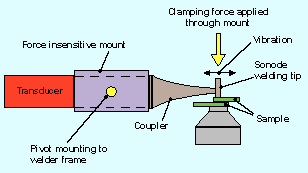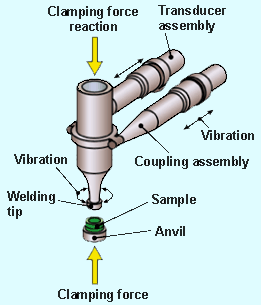September 1998
Dr Wendy B Hanson and Dr John A Fernie
Dr Wendy Hanson CEng, MIM is the Technology Manager - Ceramics, in TWI's Advanced Materials and Processes Department. Dr John Fernie EurIng, EurPhys (formerly with TWI) is now Technical Manager at Morganite Thermal Ceramics Ltd.
The 1980s saw a 'boom time' for engineering ceramics, and emerging materials such as silicon nitride and SiAlONs were predicted to become major players in several industries, replacing metallic components on a large scale. For over a decade, intensive effort went into these new materials and one of the goals was an attempt to construct the all-ceramic car engine. Regrettably, reality failed to match up to expectation and promise. The reality today is, that ceramics have an important part to play where they add functionality, or provide added benefit to a component, e.g. as wear surfaces, ultra-hard materials in cutting tools, for corrosion resistance or high temperature protection.
Since the ceramic is not generally used in isolation, joining has been acknowledged as a key enabling technology for the integration of ceramics. However, it is an area often neglected during the design process. Many an engineer will incorporate ceramics into a component as though it was a high performance metal, giving little thought to service conditions or joining operations. This can lead to two outcomes 1) the part fails giving rise to the conclusion that the ceramic was unfit for purpose and that there should be a return to metals or 2) if a ceramic must be used then an expensive redesign may be required.
While there are many important issues to be considered alongside joining, such as materials selection, best practice and joint design, this article only considers ceramic joining technologies and in particular, some of the novel ways of producing ceramic-ceramic and ceramic-metal bonds. Descriptions of the more conventional methods used can be found in the further reading section.
The joining technologies used today - few of which have been developed specifically for this class of materials - range from simple mechanical attachment, (for example the compression fit used in spark plugs, Fig. 1), through liquid phase processes such as adhesive bonding and brazing (the thermal protection system for the space shuttle uses adhesives, or the ceramic turbocharger rotor which uses brazing, (Fig. 2). However, there are problems associated with these processes, including processing considerations (such as component size, joining atmosphere), time constraints and costs. It is for these reasons that new ceramic joining technologies, such as the ones described below, are under development.
Fig. 1 Sparky performance ceramic spark plugs made from alumina are produced via compression fitting
Fig. 2 Ceramic turbocharger rotor assembly made from silicon nitride. (Picture courtesy of NGK/NTK Spark Plug Co)
Ultrasonic Joining
Ultrasonic joining (used extensively in the plastics industry) has been applied to such ceramic-metal combinations as alumina-aluminium, alumina-stainless steel, zirconia-steel and glass-ceramic (cordierite based)-copper. Typical applications include batteries, thread guides, textile cutting equipment and heavy-duty electrical fuses. The advantages of the process are the very fast joining times (less than 1 second), surface preparation is not critical (which is contrary to almost every other ceramic joining process) and the lack of melting and intermetallic formation. However, for joining of hard metals such as steel, soft, deformable interlayers are needed. A limitation of this technique as applied to ceramics is that only films/thin sheets of metal can be joined to a ceramic.
Typically, the technique employs a transducer assembly operating at ~20kHz, which is the source of the ultrasound, coupled to a sonotrode. The sonotrode tip is placed in contact, (usually under a clamping load of 1-10N/mm2) with the workpiece, Fig. 3. The heat generated is localised at the interface (up to 600°C when using aluminium interlayers).
 |
 |
|
Fig. 3 Set-up for ultrasonic welding
|
The bonding mechanism relies on the vibratory shear stress of the metal exceeding its elastic limit, coupled with the breakdown of surface oxide films, thus exposing atomically clean metal. The clamping force exerts plastic deformation on the metal, which increases the interfacial contact between the metal and ceramic. Then, mechanical keying occurs across the interface and the joint is formed, perhaps with a contribution from chemical interactions.
In future, this technique could be applied to gas-tight container seals (lamps), optical components and the joining of metallic membranes onto ceramic bodies.
Transient Liquid Phase Bonding (TLPB)
TLPB has the ability to produce a bond at a lower temperature than that at which it will be ultimately used. The technology is currently being adapted for a number of ceramics using 'interlayers' based either on glasses, (such as oxynitrides for joining SiAlON) or pure metals or alloys, (such as Ge and Ge-Si for joining SiC and SiC/SiC composites). The schematic representation for bonding in the SiAlON system is given in Fig. 4. A mixture of silicon nitride, yttria, silica and alumina are applied (by spray coating) to one surface of the joint. As the samples are heated to 1600°C, a load of 2MPa is applied. Joint formation occurs at this temperature over a period of 10 to 80 minutes. At ~1400°C, the oxide components react to form a Y-Si-Al-O liquid phase. This leads to densification and sintering. The silicon nitride then dissolves into the liquid, boosting both Si and N contents and altering the composition to Y-Si-Al-O-N. At the same time, beta-SiAlON grains grow and form an interlocking network a
Fig. 4 Transient liquid phase bonding process (after Walls and Ueki, J Am Ceram Soc, Vol 75, 1992)
The weakness of the TLPB method is that a favourable reaction between the interlayer and substrates is required. For silicon nitrides, the glassy interlayer must redistribute itself and penetrate the adjoining microstructure.
Infiltration Processes
High strength, high temperature capability materials for operation in excess of 1000°C, such as SiC based composites, are required for structural applications, including heat exchangers and gas turbine components. The substitution of these materials is in recognition that traditional stainless steels and superalloys have reached their operational limits. There is a demand from industry to develop a robust joining process suitable for both SiC monolithic and composite materials. The use of polymers which react with and infiltrate into the bulk material offer a potential solution.
A mixture of polymer precursor (a source of carbon), aluminium, boron and silicon is applied to the joint surfaces (in a tape, paste or slurry) and then heated (generally to 1200°C) in an inert atmosphere and/or air (using a propane torch, or furnace). The joint forms through polymer pyrolysis of the precursor material which subsequently reacts with the added elemental Si (in the presence of sintering aids of Al and B), to form in-situ, high density SiC. Strengths have ranged from ~95MPa for air-joined samples, to ~40MPa for argon atmosphere samples. The very fact that the joint can be produced using a simple gas torch could have a large impact on the repair, or on-site production of ceramic-ceramic joints. To date various grades of SiC, SiC/SiC and C/SiC composites have been joined using this technique.
Microwave Joining of Ceramics
Microwave energy is already being applied to the drying/firing of refractories and whiteware; however, it has recently been considered as an energy source for joining ceramics such as alumina, zirconia, mullite, silicon nitride and silicon carbide. The direct coupling of the microwave with the ceramic results in volumetric heating, hence there is a great potential to heat large sections uniformly. Control of the location of maximum electric and magnetic fields also enables precise, selective heating. Conventional diffusion bonding techniques use radiant heating methods and therefore the time to reach temperature and the time at bonding temperature can be up to 8 hours. This is particularly so for materials such as alumina, which are diffusion bonded at temperatures approaching 1600°C. By use of a microwave heat source, these bonding times can be reduced by an order of magnitude.
Very high purity aluminas are difficult to heat, due to low inherent dielectric properties, making joining difficult. However, relatively impure 85% alumina is joined with little difficulty. The inability to produce joints between the high purity alumina has led to investigations on the use of interlayers including sealing glasses and alumina gels. The latter of these offers the advantage that, at the joining temperature, the gel transforms into colloidal alpha alumina which subsequently sinters to provide an homogeneous interface. Joints produced between 85% alumina have shown bond strengths equivalent to that of the parent material. The mechanism of joint formation has been studied and a number of possible mechanisms have been identified, depending on the material. For impure aluminas, the glassy grain boundary phase softens and assists in the bonding process, Fig. 5, whilst for zirconia, a solid state process has been identified.
Fig. 5 Electron micrograph of alumina-alumina joint produced by microwave diffusion bonding
Fig. 6 Silver-based braze alloy reinforced with Sic particulates
Ceramic-Modified Braze Alloys
Whilst work at TWI is focused on the more traditional methods of joining ceramics, such as brazing, diffusion bonding, glasses and adhesives; current development programmes are investigating the modification of braze alloys by the addition of a ceramic reinforcement, Fig. 6. This will provide a joining medium with a coefficient of thermal expansion (CTE) intermediate to that of ceramics and metals and also give the joint improved strength due to the introduction of a second phase, i.e. an in-situ metal matrix composite. Whilst the additional joint strength is, in effect, a bonus, it is the ability to tailor the CTE of the joining medium that is of interest, since this raises the possibility of designing the braze to accommodate thermal stresses which would otherwise build up during the joining process.
Novel Polymer Adhesives
Fig. 7 Transparent nanocomposite materials with 25% ceramic loading, prepared via sol-gel processing
For low temperature applications, novel, organic based adhesives reinforced with nano-sized ceramic particles are being fabricated at TWI using sol-gel chemistry (a liquid phase process). The use of this technique allows intimate mixing of the ceramic and organic constituents (on a molecular scale) and this produces materials with high purities and a high level of homogeneity, Fig. 7. This process provides a joining medium, which is tough and yet flexible and can be designed to be hydrophobic and self-repairing. Applications for these strong, modified adhesives may be found in the optical, biomedical and defence industries.
Summary
Ceramic joining processes have evolved from derivations of metal and plastic joining techniques into their own discrete technologies; however, improvements and modifications to these existing technologies are still required to make them more readily adaptable. In association with this, the selection of the appropriate material and joint design are critical factors when developing joining technologies.
Increasingly, more development on ceramic joining begins with a design exercise on the modelling of new component designs and joint geometries. Modelling carries a great deal of significance when implementing ceramics into new applications, since it can lessen expensive trial and error failures on material selection, joint design and the selection of the appropriate joining procedure and process cycle. The difficulty faced in the modelling approach is the lack of reproducible material property data for ceramics and joining media such as brazes, solders, adhesives etc. If incorrect data is put in, incorrect joint designs will be produced and will give poor support to the decision making process. Therefore, much work is concentrating on the development of appropriate data to plug into the models. Until then, the use of modelling for ceramic joint development will generally be backed up by a series of practical trials.
Further reading
- 'Ceramic Joining', ed I E Reimanis, C H Henager, A P Tomsia, Ceramic Transactions Volume 77, American Ceramic Society, 1997
- 'Structural Ceramics Joining II', ed A J Moorhead, R E Loehman, S M Johnson, Ceramic Transactions Volume 35, American Ceramic Society, 1993
- 'Joining of Ceramics', ed M G Nicholas, Chapman and Hall, 1990